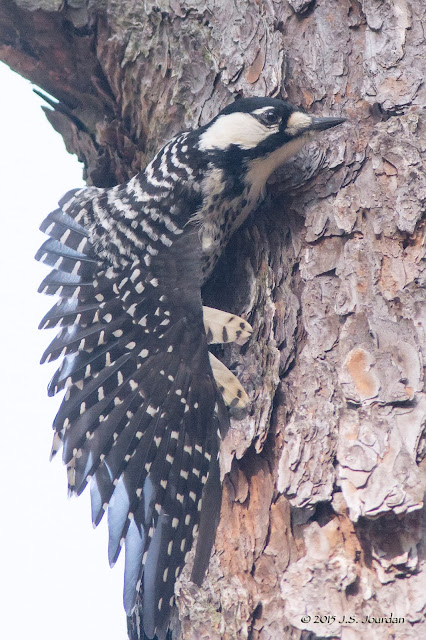The White-cheeked Woodpecker! - 13 Nov 2015
I arrived at the Visitor's Center shortly before 9 am and inquired about the possibility of seeing a RCWP. The nice lady behind the visitor's desk was gracious enough to walk me outside to the back of the Visitor's Center and point out several trees where a pair had nested this year and could be seen daily. Of course, they were nowhere to be seen... We then headed around to the front of the Center and listened for their mouse-like squeaks, which we did not hear, either. But she pointed me to the trails and promised that they would be back around 5:30 pm this evening. I had hoped to see one a bit sooner as I needed to be back in Raleigh by mid-afternoon. So, I thanked her profusely and headed out on the Pine Barrens Trail with the hopes of seeing at least a glimpse of one of these endangered birds.
I stopped every 100 yds or so and did point surveys, but heard and saw nothing. Still, I enjoyed the scenery and felt at home on the trails. Near the creek the trees opened enough to reveal some large snags with numerous cavities. A pair of Pileated Woodpeckers belted out their loud "Wik-Wik-Wik" call, but would not appear close enough for pics.
Yep, the phone rang. It always rings when a great bird is found, so I immediately felt validated. Thanks for the call, Dan! Luckily it was only a few second call from work, and even though the woodpecker posed in the mid-morning sunlight that was streaming through the trees, I at least could soak it in while desperately trying to hang up.
Thrilled that I had finally gotten pics of one of North America's rare and endemic birds I did what everyone does in a situation like this. I ran into the Visitor's Center and bought a sweatshirt and coffee mug!
The Red-cockaded Woodpecker gets its name from a tiny red spot (or "cockade") that is located on its cheek under its eye. The spot is virtually invisible in the field so a better name may be White-cheeked Woodpecker, which is the distinctive field mark that differentiates it from other black-n-white woodpeckers. The birds are cooperative breeders, with breeding pairs assisted by former offspring (usually males) that help excavate cavities in live pine trees. Sap from the holes help discourage snakes and other cavity nesters from competing for the holes (like Eastern Bluebirds).
Many thanks to the good folks at Weymouth Woods Sandhills Nature Preserve for helping me locate and know what to look for when chasing these birds.
Weymouth Woods Sandhills Nature Preserve, Moore, North Carolina, US
Nov 13, 2015 9:00 AM - 11:00 AM
Protocol: Traveling
2.0 mile(s)
Checklist Comments: Pine Barrens Trail
6 species
Yellow-bellied Sapsucker (Sphyrapicus varius) 1
Red-cockaded Woodpecker (Dryobates borealis) 3
Pileated Woodpecker (Dryocopus pileatus) 2
Carolina Chickadee (Poecile carolinensis) 4
White-breasted Nuthatch (Sitta carolinensis) 2
Brown-headed Nuthatch (Sitta pusilla) 6
View this checklist online at https://ebird.org/checklist/S1
This report was generated automatically by eBird v3 (https://ebird.org/home)
Nov 13, 2015 9:00 AM - 11:00 AM
Protocol: Traveling
2.0 mile(s)
Checklist Comments: Pine Barrens Trail
6 species
Yellow-bellied Sapsucker (Sphyrapicus varius) 1
Red-cockaded Woodpecker (Dryobates borealis) 3
Pileated Woodpecker (Dryocopus pileatus) 2
Carolina Chickadee (Poecile carolinensis) 4
White-breasted Nuthatch (Sitta carolinensis) 2
Brown-headed Nuthatch (Sitta pusilla) 6
View this checklist online at https://ebird.org/checklist/S1
This report was generated automatically by eBird v3 (https://ebird.org/home)



























Nice post, Jerry! I have fond memories of that place. I got my lifer Red-cockaded there about two years ago exactly.
ReplyDelete